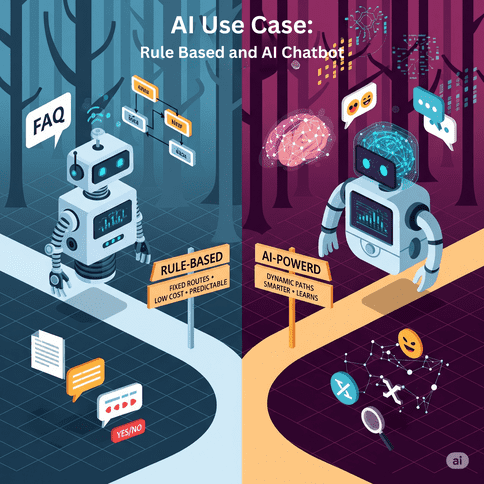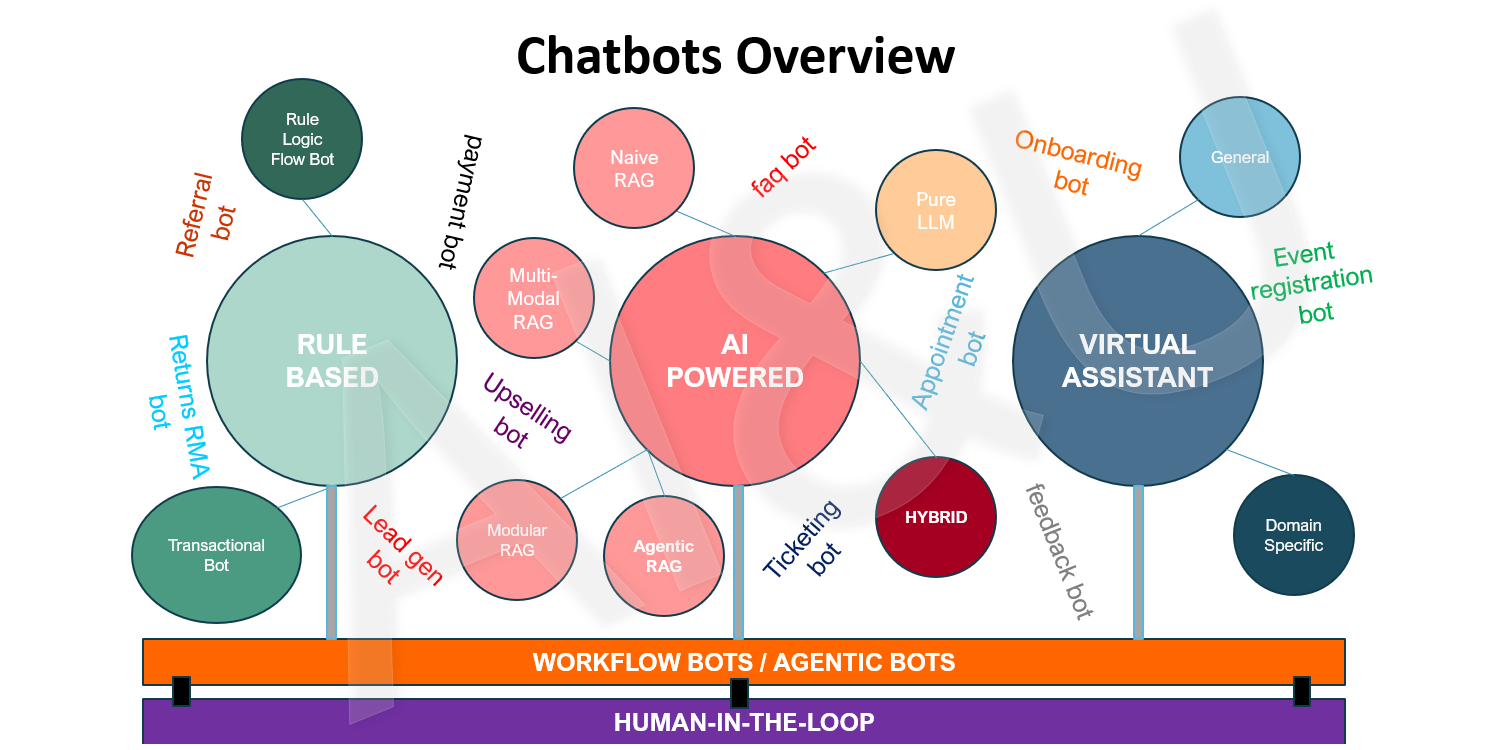Introduction: The World of Chatbots as a Spectrum
Imagine walking into a car dealership. You’ll find everything from a basic economy car that gets you from point A to point B, to a luxury sedan with advanced AI-powered features, to a fully autonomous vehicle that practically drives itself. Each serves a purpose, each has its place, and each comes with different costs, capabilities, and complexities.
The world of chatbots works exactly the same way.
Just as you wouldn’t buy a Formula 1 race car for your daily grocery runs (or a bicycle for cross-country road trips), choosing the right chatbot for your business isn’t about finding the “best” one—it’s about finding the right fit for your specific needs, budget, and goals.
The chatbot landscape spans from simple, rule-following assistants that can handle basic questions with the reliability of a well-tuned engine, all the way to sophisticated AI companions that can understand context, learn from conversations, and adapt their responses like a seasoned customer service representative who’s been with your company for years.
But here’s where it gets tricky: unlike cars, where you can easily see the difference between a compact car and an SUV, chatbots often look identical from the outside. They all have that familiar chat interface, they all respond to your messages, and they all claim to make your business more efficient. The real differences lie under the hood—in how they think, learn, and solve problems.
In this comprehensive guide, we’ll take you on a journey through the entire spectrum of chatbot types, from the fundamental building blocks to the cutting-edge innovations that are reshaping how businesses interact with their customers. By the end, you’ll have a clear roadmap for choosing the perfect digital assistant for your unique needs.
Let’s start by understanding the two foundational categories that form the backbone of all chatbot technology.
Section 1: Rule-Based vs. AI Chatbots – The Foundation of Digital Assistance

Think of the difference between following a recipe and being a master chef. A rule-based chatbot is like a diligent cook who follows every recipe step-by-step with perfect precision, while an AI chatbot is like a creative chef who understands the principles of cooking and can improvise, adapt, and create new dishes based on available ingredients and customer preferences.
Rule-Based Chatbots: The Reliable Recipe Followers
Rule-based chatbots, also called decision-tree chatbots or scripted chatbots, operate on a simple but powerful principle: “If this, then that.” They’re essentially sophisticated flowcharts brought to life, where every possible conversation path is pre-planned and programmed by their creators.
Imagine a customer service representative who has been given a comprehensive manual that covers every possible question and the exact response they should give. That’s essentially how rule-based chatbots work—they match your input to their predetermined rules and respond accordingly.
Advantages of Rule-Based Chatbots:
- Predictable and reliable: Like a well-maintained car, they perform consistently every time
- Quick to deploy: You can have one running in days or weeks, not months
- Cost-effective: Lower development and maintenance costs
- Easy to control: You know exactly what they’ll say and when
- Perfect for structured processes: Excellent for FAQs, order tracking, or appointment booking
Limitations of Rule-Based Chatbots:
- Limited flexibility: Can’t handle questions outside their programmed scope
- Frustrating for complex queries: Users often hit dead ends
- High maintenance: Every new scenario requires manual programming
- No learning capability: They don’t improve from interactions
Best Use Cases: Rule-based chatbots excel in scenarios with predictable, repetitive interactions—think customer support for common questions, lead qualification forms, appointment scheduling, or simple e-commerce assistance.
Remember the bank chatbot where they only allow you to check account balance, report card lost, card activation or fee waiver else, you can choose to chat with human. Any other topic you mentioned, they will keep bringing you back to these few options.
AI Chatbots: The Adaptive Problem Solvers
AI chatbots represent a quantum leap in conversational technology. Powered by Natural Language Processing (NLP) and Machine Learning, these digital assistants can understand context, learn from interactions, and generate human-like responses that go far beyond simple if-then logic.
Think of them as the smartphone equivalent in the chatbot world—while a basic phone can make calls, a smartphone can adapt to your needs, learn your preferences, run countless applications, and even anticipate what you might want to do next.
Advantages of AI Chatbots:
- Natural conversation flow: Can handle complex, multi-part questions
- Contextual understanding: Remembers earlier parts of the conversation
- Continuous improvement: Gets smarter with every interaction
- Handles ambiguity: Can interpret unclear or poorly worded questions
- Scalable intelligence: Can manage multiple topics simultaneously
Limitations of AI Chatbots:
- Higher complexity: Requires more sophisticated development and training
- Potential unpredictability: May occasionally provide unexpected responses
- Resource intensive: Needs more computational power and ongoing management
- Training requirements: Requires substantial data and time to reach optimal performance
Best Use Cases: AI chatbots shine in customer service scenarios requiring empathy and problem-solving, complex product recommendations, technical support, sales conversations, and any situation where users might ask questions in unpredictable ways.
Key Comparison: Rule-Based vs. AI Chatbots
| Feature | Rule-Based Chatbots | AI Chatbots |
|---|---|---|
| Setup Time | Days to weeks | Weeks to months |
| Development Cost | Low ($1,000-$10,000) | Medium to High ($10,000-$100,000+) |
| Maintenance | High (manual updates) | Low to Medium (self-improving) |
| Conversation Quality | Rigid but accurate | Natural and flexible |
| Learning Ability | None | Continuous improvement |
| Best For | Simple, predictable tasks | Complex, varied interactions |
| User Frustration Risk | High (when going off-script) | Low (adapts to user needs) |
| ROI Timeline | Immediate | 3-6 months |
| Technical Expertise Required | Low | High |
| Scalability | Limited by pre-programmed paths | Highly scalable |
The Reality: Hybrid Solutions Lead the Way
Here’s the secret that many businesses discover after implementing their first chatbot: the most successful deployments often combine both approaches. Modern chatbot platforms increasingly offer hybrid solutions that use rule-based logic for structured processes (like gathering contact information) and AI capabilities for open-ended conversations.
Think of it like a modern car with both automatic and manual driving modes—you get the reliability and control when you need it, plus the intelligence and adaptability for more complex situations.
This hybrid approach allows businesses to enjoy the best of both worlds: the predictability and cost-effectiveness of rule-based systems for routine tasks, combined with the sophistication and user satisfaction of AI-powered conversations for more complex interactions.
What’s Coming Next: Advanced Chatbot Architectures
Having established the foundation with rule-based and AI chatbots, we’ll now explore the sophisticated architectures that are revolutionizing business conversations.
In the upcoming sections, we’ll dive deep into the battle between two cutting-edge AI approaches: Retrieval-Augmented Generation (RAG) chatbots versus fine-tuned LLM chatbots—think of it as the difference between adding a powerful aftermarket GPS and knowledge system to your existing car versus buying a vehicle that’s been custom-built from the factory with specialized expertise baked into its very DNA.
We’ll explore the fascinating world of specialized RAG implementations, from simple document-retrieval systems to sophisticated multi-modal chatbots that can process everything from PDFs to images, each designed for specific business challenges and use cases. These advanced architectures represent the current frontier of chatbot technology, where businesses can achieve unprecedented levels of accuracy, relevance, and user satisfaction.
Finally, we’ll also examine hybrid chatbots that combine rule-based reliability with AI intelligence, operating like the plug-in hybrids of the conversational world—giving you electric efficiency for routine trips and gas-powered flexibility for longer journeys.
I wanted to do only one blog for the different types of chatbots. I then discovered that whatever I learned in the last 6 months there are so much more information that I need to do a series about it! So stick around to find out more!
Read: Part 2:
